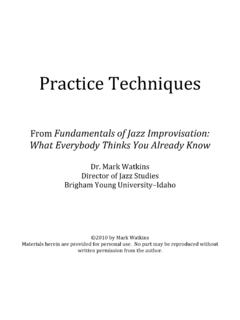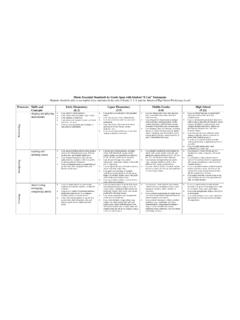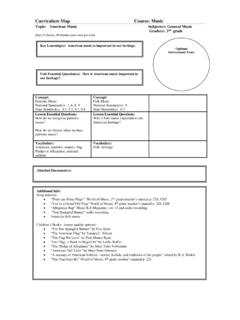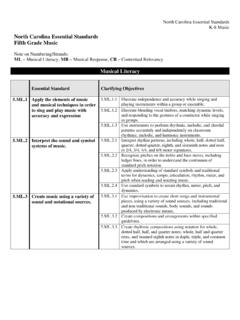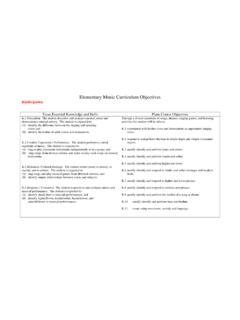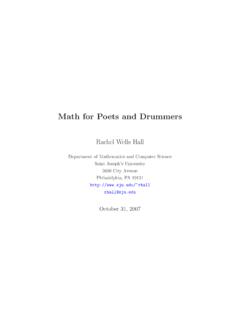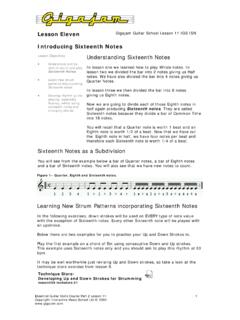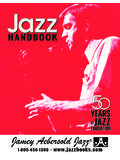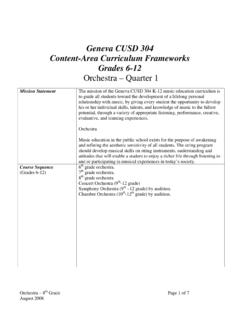Transcription of FROM RHYTHM PATTERNS TO PERCEIVED TEMPO - JKU
1 FROM RHYTHM PATTERNS TO PERCEIVED TEMPOK laus Seyerlehner1, Gerhard Widmer1,2, Dominik Schnitzer1,21 Department of Computational PerceptionJohannes Kepler University Linz, Austria2 Austrian Research Institute for Artificial Intelligence, ViennaABSTRACTT here are many MIR applications for which we would liketo be able to determine the PERCEIVED TEMPO of a song au-tomatically. However, automatic TEMPO extraction itself isstill an open problem. In general there are two TEMPO ex-traction methods, either based on the estimation of inter-onset intervals or based on self similarity predict a TEMPO the most significant time-lag or themost significant inter-onset-interval is used.
2 We proposeto use existing RHYTHM PATTERNS and reformulate the tempoextraction problem in terms of a nearest neighbor classi-fication problem. Our experiments, based on three dif-ferent datasets, show that this novel approach performs atleast comparably to state-of-the-art TEMPO extraction algo-rithms and could be useful to get a deeper insight into therelation between PERCEIVED TEMPO and RHYTHM INTRODUCTIONThe TEMPO is a basic and highly descriptive property of asong, and it is a feature that music users perceive in anintuitive and direct way. TEMPO is one of the parameters auser would love to have under control.
3 For instance, onecan imagine that depending on her mood, a user wouldlike to be able to choose faster or slower music. Thereforetheperceived TEMPO , the PERCEIVED speed of music, wouldbe a perfect and highly intuitive parameter for various newinterfaces to music automatic extraction of TEMPO information directlyfrom digital audio signals has attracted a lot of TEMPO determination methods generally proceedin two stages: extracting low-level information related toapparent periodicities in the signal (we will use the genericterm RHYTHM PATTERNS for this information), and deter-mining some assumed TEMPO from this information.
4 Tobe useful in MIR applications, the TEMPO that is inferredby an algorithm should match the TEMPO human listen-ers intuitively perceive when listening to the music, notsome theoretical TEMPO that might be deduced from awritten score of the piece. It is in this sense that we willuse the termperceived tempohere, to denote the tempothat most human listeners would assign to a piece. (Ofcourse, TEMPO may be PERCEIVED differently and may bec 2007 Austrian Computer Society (OCG).ambiguous in certain cases, but in general, there will besubstantial agreement.) In the evaluation of our TEMPO ex-traction method in this paper, we will use music collec-tions manually annotated with TEMPO values; we will haveto assume that the annotations correspond to the tempothat most listeners would a lot of literature on the subject, the humanperception of rhythms, periodicity and pulsation is not yetvery well understood.
5 The same is true for the relation be-tween RHYTHM and TEMPO perception. Compared to rhythmpatterns, which we consider to be low-level features, theperceived TEMPO is a more abstract higher level feature. Acommon approach in TEMPO identification is to analyse theextracted RHYTHM patters (even if they not usually calledso see section below), assuming that one of the pe-riodicities present in the RHYTHM PATTERNS corresponds tothe PERCEIVED TEMPO . This is usually determined by usingsome simple peak picking algorithm to predict the mostsalienttempo. However, the relation between rhythmicpatterns and TEMPO perception might be more complex,and simple peak picking algorithm might not be the mostappropriate choice.
6 While a lot of scientific work has fo-cused on onset detection and RHYTHM pattern extraction,there has been little effort to gain further insight into thisrelation between RHYTHM and PERCEIVED TEMPO to improvethe TEMPO estimation step. We propose to view this rela-tion as a sort of machine learning problem. We model theoveralltempo extraction processas a two stage processofrhythm pattern extractionandtempo estimation, andwill investigate whether the prediction of PERCEIVED tempofrom RHYTHM PATTERNS can be learned by the BASIC PERCEIVED TempoPerceived TEMPO is not a well-defined mathematical con-cept, since the perception of the TEMPO of a song stronglydepends on the listener.
7 It is well known that a human spreferred TEMPO range is around 100 to 120 bpm. Butwhat makes PERCEIVED TEMPO estimation really difficult isthe fact that the PERCEIVED TEMPO of certain pieces mightbe ambiguous, and human subjects may indeed perceivedifferent tempi in the same piece, as has been confirmedin tapping experiments [10]. Not unexpectedly, many ofthe discrepancies in users tapping choices relate to differ-ent choices of the main metrical level; thus, users tempojudgments often differ by a factor of two or , it is not yet clear if ambiguities knownfrom tapping experiments really correspond to ambigui-ties in TEMPO perception.
8 According to Chua et al. [1, 7],the Foot-tapping tempois not always the same as theperceived TEMPO . This is supported by Zhu et al. [3], whocarried out a user study where the subjects had to deter-mine the TEMPO with respect to some reference clips. Theyfinally conclude that the perception biases between differ-ent individuals are not large, so that the notion of a uniqueperceived TEMPO might still be practically deal with the ambiguity problem, some authors haveproposed to extract two main tempi as well as their rela-tive strength ( , [10, 5]). For a TEMPO descriptor thatshould support user interaction, this is rather a user interface having a TEMPO slider, such thata user can influence the TEMPO by selecting another temporange.
9 Such an interface obviously presupposes a uniquetempo of our interest in a useful TEMPO descriptor forMIR applications, we decided to focus on the estimationof themajororstrongestperceived TEMPO of a piece, thetempo most people would decide for. This seems reason-able, as many pieces have unambiguous PERCEIVED instance, DJs rely on beat databases to increase thespeed of the songs during an event from slow to fast section we will make use of such publicly availabletempo information from beat databases to create a repre-sentative ground truth RHYTHM PatternsAll TEMPO extraction algorithm have more or less the samecommon structure.
10 In a first stage, information related topotential periodicities is extracted from the digital audiosignal ( RHYTHM pattern extraction process), and in a sec-ond final stage a TEMPO is estimated from the extractedpattern ( TEMPO estimation process). For a comprehensiveoverview on TEMPO extraction algorithms we refer to [4],who summarize the results of theISMIR 04tempo ex-traction contest. A detailed description of various state-of-the art TEMPO extraction algorithms can also be foundon theMIREX 06homepage1. In this section we givea brief overview of various representations of rhythmicstructures one can extract from music signals.
